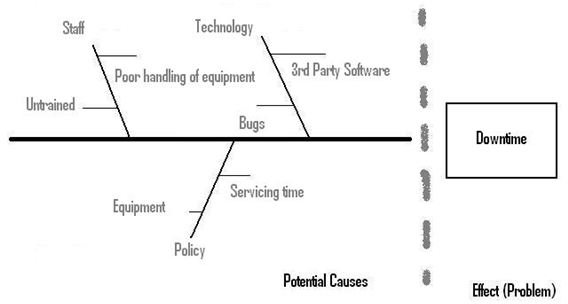
During the year 1968, while working as a full-time professor at the Faculty of Engineering at the University of Tokyo, Ishikawa studied the concept of quality and introduced the seven quality management tools for projects’ improvement in his book Guide to Quality Control. Japanese organizational theorist Kaoru Ishikawa(石川 馨)was born in 1915 in Tokyo, Japan, and he is considered a key figure in the development of quality initiatives.
Ishikawa diagram in pmp how to#
Finally, it reflects critically on its limitations and makes recommendations on how to maximize the diagram’s utility.ĭescription of Ishikawa fishbone diagram Historical overview Additionally, the article displays the technique’s benefits and refers to its disadvantages. Also, it briefly presents its implementation on the Apollo 13 incident. Based on three papers that study and utilize the fishbone diagram on specific cases and the Project management book by Dennis Lock, this article analyzes its basic components and provides detailed guidance to the building of the diagram. It is commonly used by safety and reliability engineers to detect faults in construction.įirstly, this article gives a historical overview of Kaoru Ishikawa, who invented and named the diagram.


It heavily relies on the idea that minor problems matter and can lead to causes that affect badly the existing project. The diagram provides a visualization that simplifies the identification of risks and categorizes them. This article introduces the Ishikawa fishbone diagram as a method to analyze numerous reasons why a project may fail. Once identified and listed those risks can be categorized using qualitative risk analysis. Thus, identifying possible risks is a key challenge for every project. Besides, their result ranges from minor inconvenience to disruption of the project. Possible risks for a running or finished project are countless and may vary from anticipated to unexpected.

It is well established that every project at every stage carries risk. Risk project management is a broad and complex field. 3.3 Fishbone diagram combined with components of safety management framework in developing of solutions.3.2 Fishbone diagram combined with risk management models in order to rank the problems.3.1 Fishbone diagram combined with data analytics in data driven companies.2.3 The fishbone diagram implemented on the Apollo 13 incident.2 Description of Ishikawa fishbone diagram.


 0 kommentar(er)
0 kommentar(er)
